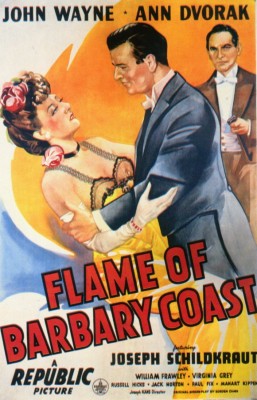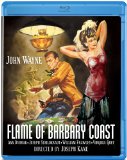| Reviews & Columns |
|
Reviews DVD TV on DVD Blu-ray 4K UHD International DVDs In Theaters Reviews by Studio Video Games Features Collector Series DVDs Easter Egg Database Interviews DVD Talk Radio Feature Articles Columns Anime Talk DVD Savant Horror DVDs The M.O.D. Squad Art House HD Talk Silent DVD
|
DVD Talk Forum |
|
|
| Resources |
|
DVD Price Search Customer Service #'s RCE Info Links |
|
Columns
|
|
|
Flame of Barbary Coast
Despite what now many would identify as an "unrestored" image, the high-def video transfer of Flame of Barbary Coast (not "Flame of the Barbary Coast") is nonetheless excellent, and a real pleasure to see.
On the Pacific coast, Montana rancher Duke Fergus (Wayne) meets Flaxen Terry (Ann Dvorak), headliner at the El Dorado, the biggest casino on the Barbary Coast. He also meets Tito Morell (Joseph Schildkraut), its aristocratic owner and also Flaxen's fiancé. Duke is riding into town to collect a $500 debt from Morell, and since Morell doesn't identify himself, it's not until Duke is seated at the casino and given a complimentary bottle of champagne that he realizes the men are one and the same. (They also exchange a decidedly risqué series of double-entendres comparing Flaxen to a horse.)
Flaxen becomes jealous when Tito becomes attracted to aspiring showgirl Rita Dane (the always reliable Virginia Grey, very alluring here in a too-small part). To teach Tito a lesson, Flaxen thwarts the various rigged gambling devices and other trickery at the El Dorado and all the other big houses, until a delighted Duke's bankroll is worth a fortune. Drunk with success, Duke finally and abruptly loses everything back to Tito, and returns home to Montana.
However, itching to go back, Duke enlists the aide of professional gambler Wolf Wylie (William Frawley), who tutors him to cheat at cards and out-grift the professional grifters. Duke uses his winnings to build his own, rival casino, the Silver Dollar, whose opening is interrupted by the roughly 8.0 magnitude earthquake striking the heart of the city at 5:12 am on the morning of April 18, 1906.
Flame of Barbary Coast works best in capturing the color and dangerous glamour of the period, gorgeously depicted here in an expansive backlot set and cavernous interiors of gaslight and ornate decorations in authentic style.
All of the early scenes are good: Duke's introduction to the city, his early encounters with Tito and flirtations with Flaxen play well, and Duke's incredible (if fixed) run of extraordinary luck at the various casino and the sensation it causes entertains. Also good are all the scenes of Duke learning the gambling trade from veteran Wolf Wiley, hinting at the later teacher-student relationship of Paul Newman and Robert Redford in The Sting (1973). Once Duke builds his own casino, things begin to fall apart, literally. The Big Earthquake is a huge disappointment. Republic Pictures had two of the best special effects men in the business, brothers Howard and Theodore Lydecker, but the film uses very little of their top-notch miniature photography, instead relying mostly on the collapsing of full-size sets.
Even in 1945, MGM's hugely popular San Francisco (1936), starring Clark Gable, Spencer Tracy, and Jeanette MacDonald, with its not-dissimilar plot, was still reasonably fresh in the public's mind, and that earlier film's earthquake climax is far superior and still holds up well today. Of course the MGM production had a large budget, $1.3 million versus Flame of Barbary Coast's $600,000, less than half, but the earthquake still should have been bigger and more exciting than it turned out.
Ann Dvorak (pronounced ‘dvor-zhak' according to the actress herself -- for years I thought it was ‘da-vor-ak'), better remembered for her Warner Bros. movies of the early and mid-1930s, especially her unforgettable Vivian in 3 on a Match (1932).* She seems out of place here as a glamorous, dollied-up showgirl. Schildkraut is certainly a change of pace in the heavy role; usually Wayne's antagonists were burly, barrel-chested men his physical equal, people like Brian Donlevy, Albert Dekker, and Ray Middleton, not diminutive aristocrats half his size.
Video & Audio
As with other John Wayne-Republic titles handled by Olive Films, Flame of Barbary Coast looks great. There are scads of minor negatives scratches throughout, but the blacks are rich and the picture, at times, razor-sharp. The DTS-HD Master Audio, in its original mono, English only with no subtitle options, is also excellent. No Extra Features, sorry to say, owing to Olive's licensing agreement with Paramount.
Parting Thoughts
No masterpiece but a lot of fun for John Wayne fans, Flame of Barbary Coast is Recommended.
* Dvorak is featured in what is still one of the most shocking endings of any movie ever made.
Stuart Galbraith IV is a Kyoto-based film historian whose work includes film history books, DVD and Blu-ray audio commentaries and special features. Visit Stuart's Cine Blogarama here.
|
| Popular Reviews |
| Sponsored Links |
|
|
| Sponsored Links |
|
|
| Release List | Reviews | Shop | Newsletter | Forum | DVD Giveaways | Blu-Ray | Advertise |
|
Copyright 2024 DVDTalk.com All Rights Reserved. Legal Info, Privacy Policy, Terms of Use,
Manage Preferences,
Your Privacy Choices | |||||||















